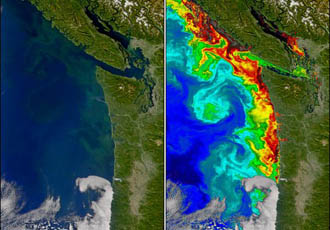Tinkering with the Earth and its atmosphere in an attempt to fend off global warming—a.k.a. geoengineering—seems like the stuff of science fiction: Lacing the stratosphere with sulfur aerosols or whitening clouds over the ocean to reflect sunlight back into space. Fertilizing the oceans with iron to help them absorb more carbon dioxide. It’s big science on a comic-book scale, and as such, it carries no small dose of risk and controversy.
“Some of these technologies seem inappropriate,” Victor Menotti, director of the International Forum on Globalization, told MoJo at a press briefing Thursday. “There’s a sort of scientific arrogance that these experiments will be manageable. But before we get into talking about a Plan B, we want to get back to how we can cut emissions.”
“People think this is still science fiction, but it’s not,” added Silvia Ribeiro, program manager for ETC Group, an environmental advocacy organization. “Science [magazine] said this conference was like geoengineering coming out of the closet.”
She’s referring to the Asilomar International Conference on Climate Intervention Technologies, where I’ve spent the past week schmoozing some of the field’s top researchers. ETC Group has circulated a letter—signed by dozens of like-minded organizations—questioning the entire conference and the motives of its attendees. (You can download the group’s report here.) Quoting the conference’s stated goal, Ribeiro said, “They are saying we are going to deploy this without asking if this is what we want.”
Well, that depends how you interpret it. Scientific arrogance aside, the researchers I met at Asilomar were neither crass nor naïve. In their view, the point of the conference was to develop guidelines for getting the public constuctively engaged in their work. As climate scientists, they understand more than most people about the potentially devastating effects of global warming, and would like us to have some way of mitigating them. And while they’re excited about the possibilities, they, too, are wary about the ethical hazards of opening a Pandora’s box. Their biggest fear—which also happens to be the biggest fear of their critics—is that if society imagines there’s an easy fix, we will delay the hard, expensive, and politically fraught work of altering our behavior and curbing our use of fossil fuels.
But that’s no reason to halt the research, argues Sam Thernstrom, an American Enterprise Institute fellow who showed up at the California meeting. (Geoengineering is popular among right-leaning think tanks; as are the views—which Thernstrom does not share—that climate change isn’t caused by human activities, or that our contribution is overhyped and may not be the primary cause.) “Climate is the hardest issue we’ve ever had to deal with,” Thernstrom says. “And geoengineering is not a quick fix—but there is no advantage to ignoring it.” Discussing climate intervention, he says, helps to keep the problem of global warming at the forefront—and in any case, it’s hard to imagine any president saying we should drop efforts to reduce carbon emissions and instead trust our fate to the geoengineers.
That’s because most of these techniques have worrisome side effects. The sulfur scheme, for example, would likely further deplete the protective ozone layer. Futzing with the upper atmosphere could alter global weather patterns as well—perhaps bringing drought to some areas and flooding to others, and causing famines and forced migration. The uneven results would almost certainly become a point of conflict between nations.
Once we start spewing sulfur into the atmosphere, scientists agree, we will need to continue for decades or more to prevent dramatic spikes in global temperatures. The sky will no longer be the deep blue we’re accustomed to: Alan Robock, a professor at Rutgers who has published extensively on the subject, and opposes any global-scale testing of this method (more on that in a later dispatch) says we’ll need to get used to a milky hue. Just about the only upside, he points out, will be the spectacular sunsets.
Still, according to the mantra of geoengineering’s boosters, the drawbacks may pale in comparison to doing nothing. Many in the Asilomar crowd (not to mention the MoJo crowd) fret that we are closing in on the point of no return: Copenhagen was a bust, more or less, and nations have done a dismal job of implementing even simple and obvious technologies that would reduce carbon output—to say nothing of changing citizens’ profligate habits. Without a Plan B, they say, or at least another Plan A—something to complement emissions cutbacks—we may well face far bigger problems than geoengineering would cause.
“Its wrong to ban research on this,” says David Hawkins, director of climate programs with the Natural Resource Defense Counsel, adding that we don’t yet know enough about the side effects and their severity. “In 50 years we could be in a place where climate change is worse than we thought.”











